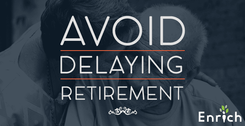Related Posts
Employers and Organizations
How Financial Wellness Programs Help Employees Retire On Time
Last Update: February 17, 2020
Delaying retirement is a growing trend among aging Baby Boomers.
Data shows that 20 percent of seniors at or above 65 are still working1 and this number is projected to increase over the next several years, even among those 75 and older.
In a survey of those nearing retirement, the Insured Retirement Institute found that six out of 10 seniors plan to work past 65 and one out of four plan to work until at least 70.2
For some seniors, working past retirement age is a choice. They enjoy their work and want to continue. For others, retiring isn’t an option--they don’t have enough money saved.
Unfortunately, working longer isn’t really a plan.
Instead, it’s a response to the lack of a real plan earlier in life and/or unexpected events that prohibited saving money.
Not only that, working longer can easily be derailed by health problems or other unforeseen circumstances, according to the Employee Benefit Research Institute.3
This trend has consequences for employers, who incur higher healthcare costs with older employees and lose promising younger employees who depart because of lack of opportunities for advancement.
Impact on Employers
A 2019 Fidelity Investments study found that when employees delay retirement, 73 percent of employers reported increased costs, 31 percent said it inhibited strategic planning and 21 percent reported lowered productivity.
Prudential found that the cost for employers is $50,000 per employee per year for a one-year delay in retirement.
For employees that delay two or more years, the costs get even higher.
Impact on Younger Workers
As Baby Boomers work longer, Gen X and millennial employees are not able to advance in their careers, according to a recent USA Today and LinkedIn survey.
More than 40 percent of millennials stated they cannot advance in their field, and 30 percent of all adults feel the same way.
This leads to younger workers changing jobs to seek advancement. In fact, 25 percent changed jobs within the last year and 30 percent plan to change within the next year.
How Financial Wellness Programs Can Help
To prevent employees from being in the situation of having to work longer, financial wellness programs can teach:
The value of participating in the company retirement plan: Not that long ago, those headed into retirement could count on getting a company pension that would provide for them in retirement.
The company took in money from employees, invested it, told employees how much they would earn each month upon retirement, and specified retirement date.
Today, pensions are mostly a thing of the past, and employers offer 401(k) benefits instead.
With a 401(k), a majority of investment decisions are placed on the employee:
- How much to contribute
- How often to contribute
- Whether to make contributions automatic
- Which investments to participate in
- The best age for retirement
- Which funds to use first after retirement
A recent Enrich/Wellable employee financial wellness survey shows that millennials are far more concerned with student loan repayment benefits than 401(k) plans, even though compounding interest has far-reaching financial benefits.
Additionally, a study by Financial Engines found that 25 percent of employees do not take advantage of company matching, leaving $24 billion on the table each year.4
How to make up for retirement savings deficits: The state of American retirement is dire, with over half (57 percent) of American workers with no retirement savings.5
The Center for Retirement Research6 determined that the median retirement balances are:
- $37,000 for those 35 to 44
- $80,000 for those 45 to 54
- $104,000 for those 55 to 64
According to the EBRI, this means that Americans have saved $4.3 trillion less than they should have.
And with the average American lifespan almost 10 years longer than it was in 1960, Americans need to be saving even more.7
How to prevent retiring with debt: In addition to the lack of savings, Americans also carry a lot of debt. The Federal Reserve Bank of New York8 provides the following debt averages:
- $67,400 for those 18 to 35
- $133,100 for those 36 to 44
- $134,600 for those 45 to 54
- $108,300 for those 55 to 64
- $66,000 for those 65 to 74
- $34,500 for those 75 and older
This debt is a combination of credit card debt, home loans, other consumer debt, and student loans for self or family members.
The Enrich/Wellable financial wellness survey found that a majority of seniors report being financially well, but an alarming 20 percent still fell into a financially unwell category.
Financial wellness programs can share options for paying down existing debt, strategies to prevent incurring more debt, how to create budgets that include saving money, and more.
Companies need to create a holistic financial education program that is individualized, looks at financial wellness from many angles, and targets employees during life events when they are most likely to need the information.
Doing so will help employees retire on time with a real plan of action, which benefits everyone.
If you want to learn more about how to help your employees get back on track for retirement, read “5 Steps to Get Your Employees Ready for Retirement.”
1 - https://unitedincome.com/library/older-americans-in-the-workforce/
2 - https://www.myirionline.org/docs/default-source/research/boomer-expectations-for-retirement-2016.pdf
3 - https://www.ebri.org/docs/default-source/rcs/2019-rcs/2019-rcs-short-report.pdf
4 - https://financialengines.com/education-center/wp-content/uploads/2016/07/Financial-Engines-401k-Match-Report-050615.pdf
5 - https://www.nirsonline.org/wp-content/uploads/2018/09/SavingsCrisis_Final.pdf
6 - https://crr.bc.edu/wp-content/uploads/2017/10/IB_17-18.pdf
7 - https://data.oecd.org/healthstat/life-expectancy-at-birth.htm
8 - https://www.newyorkfed.org/microeconomics/hhdc.html
Featured Posts

Employers and Organizations
3 MIN
10 Simple Ways Benefits Managers Can Recession-Proof Their Employee Benefits Package

Employers and Organizations
3 MIN
3 Reasons to Make After-Tax Contributions to Your Retirement Plan

Employers and Organizations
4 MIN
Financial Information vs Employee Behavior Change: Which Is More Important for Your Company’s Financial Wellness Program?

Employers and Organizations
3 MIN
Does Your Employee Financial Wellness Program Take Mindset Into Consideration?
Related Posts

Employers and Organizations
4 MIN
Does Financial Wellness Increase On-time Retirement?

Employers and Organizations
2 MIN
Find Out How YOU Can Avoid Delaying Retirement

Employers and Organizations
3 MIN
4 Misconceptions That Are Derailing Employee Retirement Readiness
